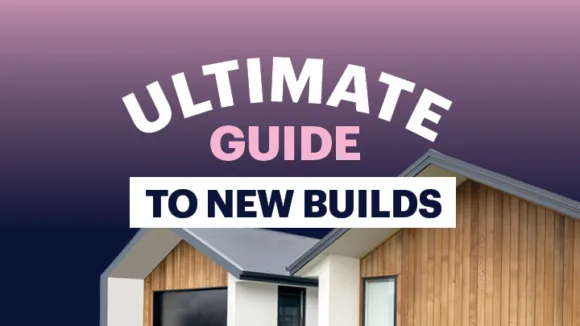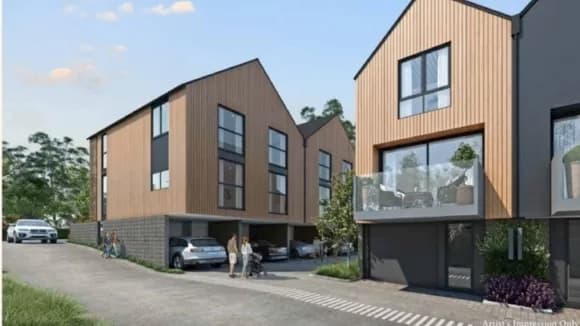
New Builds
New builds - The ultimate guide for every property investor
Explore the essentials of investing in new builds. Our guide covers key strategies, benefits, and tips to navigate the market and maximise your investment.
New Builds
9 min read

Author: Laine Moger
Journalist and Property Educator, holds a Bachelor of Communication (Honours) from Massey University.
Reviewed by: Ed McKnight
Resident Economist, with a GradDipEcon and over five years at Opes Partners, is a trusted contributor to NZ Property Investor, Informed Investor, Stuff, Business Desk, and OneRoof.
Sometimes property investors think: “I don’t like big developments … I’m not investing in one.”
This is often fuelled by a fear that since a large development will house many families, “what if it starts to look like a slum?” Or “what if I can’t get a tenant?”
And we get it. Investors want to make sure their property purchase is going to be secure for the long term.
So, in this article, we’ll discuss the four common concerns and drawbacks that go along with big developments.
You’ll also learn what you can actually do to work around any potential drawbacks to make the investment work for you.
Before we get started, we’ve got to define what we mean by a “big development”.
Here, we’re talking about a building project with 10 or more townhouses within it.
That does mean this article covers the range from a 40-strong development or a 250+ neighbourhood. The information works for both.
Firstly, some potential investors are put off because they couldn’t see themselves living in a big development of 50+ townhouses.
It’s important to remember when investing, it doesn’t matter whether you’d live in a property yourself; you’re not the one renting it. What matters is whether a tenant would want to live there, and whether the numbers stack up.
Said another way, your 5-person family might want a large 4-bedroom home. That’s the sort of home that suits your budget and your preference.
But a couple with a young child and a lower budget will have different preferences. For them a 2-bedroom townhouse in a good area with lots of neighbours in the community might be the right fit.
To give another example, you might not like to drink Coca-Cola. But that doesn’t mean shares in Coca-Cola aren't worth buying.
Generally, it’s a good idea to keep any emotion out of property investment. Just because you wouldn’t personally choose to raise your kids in a big development doesn’t mean it’s not a cracking investment choice.
Your entire investment strategy hinges on being able to tenant your property. So sometimes investors are worried that if they buy in a big development they’ll be competing with other investors for a tenant at the same time.
For example, let’s say 200 different investors purchase a property each in a development of 200 townhouses.
Once the properties are built, what happens if they’re all looking for a tenant at the same time? Suddenly, you’re competing with 200 similar properties, all looking for the same tenant.
This is a valid concern, even in a city where rentals are in high demand.
Over the last 8 years we’ve worked on hundreds of developments here at Opes Partners. What we often find is that once properties settle in a large development it may take 2-3 weeks for the property to get a tenant.
After this, however, it is not usually a long-term concern since tenancies roll over at different times.
When running the numbers on any property, you should be allowing for 2 weeks’ worth of vacancy. This is a time where you don’t have a tenant paying you rent.
So if you put this cost in your budget, then you won’t be put out or surprised when it takes a week or two to find a tenant.
Secondly, it’s important to ask whether or not you really will be competing with lots of other investors for tenants.
For example, here at Opes we were recently involved with a large development of 219 townhouses in Mangere Bridge. So some investors naturally asked, “If I buy one of these, aren’t I competing with 218 townhouses for a tenant?”
The answer was definitely “no”.
The reason is that a large development is often built in stages. That means only a portion of properties will be trying to find tenants at the same time.
In the second stage of this development 82 properties would be built at once. And of those properties 44% were reserved for first home buyers as part of KiwiBuild.
Of the properties that were to be bought by investors, 34 were 3-beds and 9 were 4-beds.
That still seems like a lot of properties, right? Well, not compared with the demand for rentals in that area.
Over the prior 6 months, 264 3-bedroom properties were tenanted within this suburb.
That meant the 3-bed properties represented about 3 weeks’ worth of supply of rentals for Mangere Bridge’s rental market.
And the 4-beds represented about 2.5 weeks’ worth of supply.
What’s the message here? Sometimes when you buy into a big development you might think that you’ll be waiting 6 months for a tenant to turn up.
But if you buy into a development that’s:
Then perhaps you won’t be waiting nearly as long as you think. And if you do find yourself up against some competition, you can use the following tactics ...
There are ways, big and small, you can differentiate your property from others that you’re competing against.
This can start right at the point of choosing your property within a development.
Consider things like: will this property attract the sun better than others because of where it is? Or will it be close to off-street parking?
These things can set it apart, especially for those outdoor-entertaining sunseekers.
Tenants also tend to prefer properties with car parks closer to the homes and corner units, since they only have 1 direct neighbour. So selecting the right property at the start can benefit you when it comes time to look for a tenant.
Another way to differentiate is to include appliances (like a dishwasher or a fridge) or furnishing the property.
Property manager, of Opes Property Management, says a good property manager will talk through “differentiating” your property with you.
For example, they were working with an investor in Glendowie when the rental assessment suggested the property might attract a higher-income tenant. So, they suggested the landlord might like to add an EV charge point as a point of difference.
Even after differentiating your property, there are 2 others tactics to consider –
When you settle on a property, usually the first major cost you incur is the first mortgage payment. And many investors want to make sure they’ve got rent coming in to cover this payment.
So some investors will schedule their first mortgage payment a month after settlement.
For example – settle the property on February 18, and schedule the first mortgage payment to be March 17.
That means you’ve got time to find a tenant before the first mortgage payment is due.
On top of this, investors will often also schedule their mortgage payment for a few days after the 1st or the 15th of the month.
That’s because a property manager will often transfer you the rent twice per month. Once on the 1st and then again on the 15th. Setting up your mortgage payment in this way ensures that you’ve got rent coming in before the first mortgage payment is due.
Often you’ll receive a cashback from a bank when you take out a new mortgage.
This is often a few thousand dollars (e.g. $2 – $4k) and investors will typically use this money to pay lawyer’s fees or other costs of purchasing a property.
However, we have seen investors use this cashback to pay for the first month or two of their mortgage payments. Effectively, this means they are using the mortgage cashback to cover any initial vacancy their property might incur.
Most new developments only come with 1 car park per property. But some investors are worried tenants might have more than 1 car.
This means they will have to park the extra car on the street, clogging up on-street parking. This might make the property harder to tenant.
So, realistically how do you manage this?
Well, without being too blunt, there’s a reason developers don’t build extra car parks ... because people aren’t willing to pay the extra cost.
Adding an extra car park per property means the developer can’t build as many properties. That increases the cost of each property.
That’s why an extra car park might cost an additional $45,000 to $50,000 for the investor. For that extra cost to be worth it for the investor, the tenant would have to pay an extra $30-$40 a week.
We tend to find tenants aren’t willing to pay this extra cost.
Property manager says tenants' tastes are changing. In the past, only having one car park might have put a tenant off.
But today tenants are more accepting of the new 1-park per property trend.
Our last point is usually the biggest concern for wary investors.
The fear is properties will be at greater risk of looking bad over time, since there are more people living there. The thinking is more people – less individual responsibility.
But property developer Andrew Yeoman, of Atlas Property, says it’s often the case that larger developments are looked after better in the long term.
How come? Large-scale developments are required by law to have a long-term maintenance and landscaping plan.
They are also governed by either a residents’ association or body corporate {link}.
Membership is compulsory and the constitutional rules pretty strict. For example, there are rules about how loud your alarm is allowed to be. But they are there to protect you and your investment.
At the very least they will ensure all common areas are well-maintained and that your neighbour is maintaining his or her property well.
By this we mean they aren’t parking their burnt-out car on the front lawn, or painting the outside of the house lime green.
Compare this to a smaller development of 3 or 4 properties. In these instances, there often isn’t a residents’ association with set rules that tells you what your neighbours can and can’t do. This presents its own risk.
It’s worth mentioning there is also a cost benefit too. More private owners means more people to share the cost of levies and insurance.
It’s understandable why some investors could be wary of large developments. But when it comes down to it, there is often little difference between purchasing in a building project of 200 compared with a project of 6.
Yes, there are some valid concerns to consider, but consider them realistically in turn, as you would with any other property.
Usually your key criteria should still be: Purchase price, yield cashflow and location. If the property stacks up, don’t let the few extra neighbours put you off a good deal.
Journalist and Property Educator, holds a Bachelor of Communication (Honours) from Massey University.
Laine Moger, a seasoned Journalist and Property Educator holds a Bachelor of Communications (Honours) from Massey University and a Diploma of Journalism from the London School of Journalism. She has been an integral part of the Opes team for four years, crafting content for our website, newsletter, and external columns, as well as contributing to Informed Investor and NZ Property Investor.
This article is for your general information. It’s not financial advice. See here for details about our Financial Advice Provider Disclosure. So Opes isn’t telling you what to do with your own money.
We’ve made every effort to make sure the information is accurate. But we occasionally get the odd fact wrong. Make sure you do your own research or talk to a financial adviser before making any investment decisions.
You might like to use us or another financial adviser